Leakage
Many engineers are afraid of using omnidirectional microphones in a multi microphone setup with several musicians or sound sources. "Leakage" seems to be the buzzword that is often heard in such situations and, without even trying anything else, directional mics are by habit chosen. A cardioid may be the right choice, but often an omni would give a better performance, because of its sonic qualities, low handling-, wind- and pop-noise and lack of proximity effect.
Furthermore, the "leakage" in a DPA omni will sound more natural. Leakage is only a problem if it sounds bad. If the leakage from one sound source in another microphone sounds natural, it can purely be beneficial in the way that it adds natural room tone to the character of the sound source. All DPA Microphones - directional and omnidirectional - have an extremely smooth and natural off-axis response. The microphone will not only sound good on axis but also off-axis. Hereby we offer the engineer the possibility to achieve more honest and natural pick ups and a better tool to adapt his miking technique.
Channel separation
If you choose an omnidirectional microphone, channel separation may be less precise than with a directional microphone, because the omni will pick up sound from all directions. Therefore, if channel separation is preferred, the ratio between direct and indirect sound can become more unfavourable with an omni.
The omni, however, can be moved closer to the source, without the penalty of the proximity effect that occurs with a directional microphone (pressure gradient transducers). The leakage that still occurs - in an acoustic setting it cannot entirely be avoided - is at least of neutral tonal quality and may add some beautiful "air" around the instrument.
As a general rule it can be said that if we place a cardioid at a distance of 17 cm to the source, then an omni placed at 10 cm gives the same ratio of direct and indirect sound as the cardioid.
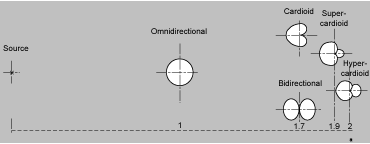
Relative distance to sound source for equal balance between direct and indirect sound
SPL handling
What about high level sound sources and a condenser microphone then? And how do I cope with the previous advice about moving an omni even closer to the sound source? Well, a DPA microphone can handle that in most cases. One of our specialities is to handle extremely high sound pressure levels (SPL). We use a pre-polarized back plate that is charged with approximately 230V, which allows us to move the diaphragm and the back plate further away from each other, without losing sensitivity. Hereby the diaphragm is able to have a bigger displacement without touching the back plate, which would make the signal clip.
Gain-to-feedback ratio
Using omnidirectional microphones in live sound reinforcement applications makes special demands on both the quality of the equipment and the experience of the sound engineer.
In general, the gain-to-feedback ratio will be reduced somewhat, which in itself can have a wide-ranging effect or almost none at all. Additionally, the characteristic of the feedback itself changes. Directional microphones tend to feedback at high frequencies while most omnis commonly feedback in the lower mid-range or bass. The feedback also builds up in a different way. Where directional microphones feedback suddenly and unexpectedly, omnis build up the feedback slowly, often starting as a low hum.
Using omnis live on stage offers a special advantage, as it is possible to adjust the gain to a constant gain-to-feedback ratio across the stage. This makes them more effective as it becomes possible for the artist to move all over the stage without suddenly stepping into a feedback zone.
Off-axis colouration
A directional microphone (the cardioid is mostly used) has - as its name implies - a directional response, with a coverage angle of approx. 130°. Sounds from the rear are at its maximum attenuated by some 30 dB but this attenuation is dependent of frequency. In other words, the cardioid might have a nice flat frequency response on-axis, but off-axis this may not be the case. In fact, some directional microphones have a notably poor off-axis response. This means that sounds entering the microphone from the sides and the rear are more or less strongly coloured - the industry names this "the curtain effect".
Even though the sound is attenuated to the sides and the rear, it will still affect the overall sound and make the reproduction more muddy or less authentic. Be sure to use a directional microphone with a clean off-axis response. The DPA cardioid types will deal with this situation in the most clean and authentic way.
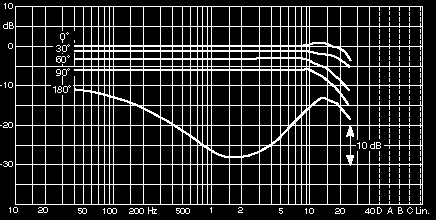
Example: On- and off-axis responses of DPA Types 4011/12/21/22/23
Polar Patterns
An omnidirectional microphone will in principle pick up sound equally from all directions. The microphone will though become more and more directional the higher the frequency. The smaller the capsule, the more true omni the microphone is.
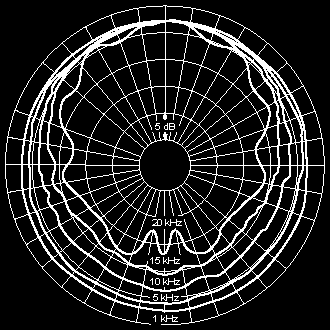
Example: DPA Type 4007
Directional microphones are seen in a number of variations, i.e. cardioid, hypercardioid and supercardioid. They differ in their rejection of sound aiming the microphone from the sides and behind but also in the pureness of the sound around the microphone.
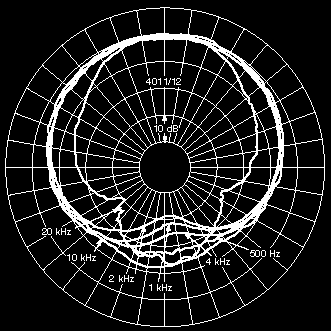
Example: DPA Type 4011
Design
The omnidirectional microphone (a pressure type transducer) is in its working principle a more simple capsule construction than a directional microphone (pressure gradient transducer). Simplicity can result in a cleaner and more dynamic sound with a flatter frequency response. Due to the nature of a single diaphragm omnidirectional microphone (the sound only excites the diaphragm from the front) the construction can also be more rugged and therefore offers even better reliability and thermal stability.
Proximity effect
To improve channel separation the microphone could be placed closer to the source. This will avoid some of the "leakage". However, when using a cardioid, the sound suffers from the so-called proximity effect; close to the source the lower frequencies are boosted. So you may end up having less leakage but a boomy sound instead. And because you are moving close to the instrument, the tonal balance in the mid- and high frequency range will also be affected. Now equalisation is needed to restore the tonal balance.
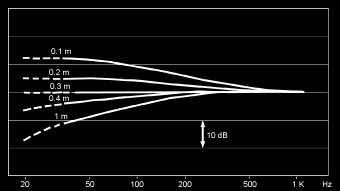
The proximity effect exhibited by the Cardioid Microphone Type 4011
Low frequency response
Omnidirectional condenser microphones have in general a more extended low frequency response and lower distortion than directional microphones in a distance of over 30 cm. In listening tests, this is often described as a "fuller or warmer response in the bass". Again, equalisation is needed on the directional microphone to compensate for the bass loss.
Wind and pop-noises
Wind and pop-noises and handling noise may also become a problem when using directional microphones. Directional microphones are far more sensitive to wind and pop noises than omnidirectional microphones, due to the use of more compliant diaphragms on directional microphones, which are more easily excited. The diaphragms on the DPA omnis are made of stainless steel or nickel. These materials can be tightened very hard and are less compliant.
Distortion
Distortion levels should also be considered when choosing between directional and omnidirectional microphones. Directional microphones tend to distort more than omnidirectional microphones, which is especially important when working with high SPL's in close miking situations. The difference in distortion between directional and omnidirectional microphones is evident, when comparing the THD specifications in DPA's product range. If using a directional microphone, be sure to use one with low distortion and high headroom before clipping.
Conclusion
From the above it can be concluded that in close miking situations, the choice of a DPA omni should be seriously considered. We strongly recommend to always make a habit of trying an omni first! It will often give a more natural sound, it can handle extremely high sound pressure levels, it does not suffer from proximity effect and is not that sensitive to wind, pop or handling noise!
| Polar Pattern |
Omnidirectional |
Directional |
| Gain to Feedback Ratio |
Lower |
Higher |
| Feedback build-up |
Slow |
Fast |
| Off-axis colouration |
Smooth and even |
Typically less smooth |
| Proximity effect |
No |
Yes |
| Sensitivity to wind, handling & pop-noises |
Low |
Higher |
| Distortion |
Low |
Higher |
| Channel seperation |
Near field: Good Diffuse
Field: Less precise |
Near field: Good Diffuse
field: Good |